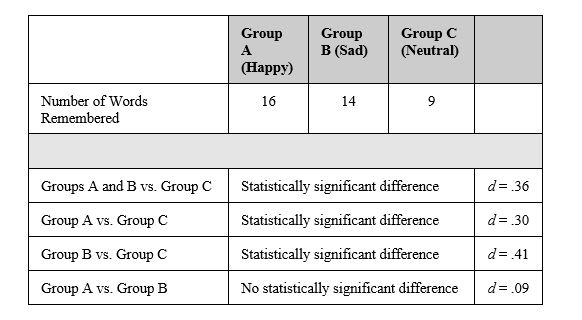RESEARCH STUDY 9.1
Dr. Lonsbary is a cognitive psychologist who is curious about how mood affects memory. She recruited 60 high school students and divided them into three groups. One group (A) listened to a 5-minute piece of music intended to make them feel happy (a song entitled "Don't Worry, Be Happy") . One group (B) listened to a 5-minute piece of music intended to make them feel sad (a song entitled "Alone Again") . One group (C) listened to no music and instead was asked to sit quietly for 5 minutes (thought to make them feel neutral) .
When a participant would come to her laboratory, she would greet the participant and then ask him or her to draw a card. If the participant drew a 1, 2, or 3, he or she was assigned to Group A. If the participant drew a 4, 5, or 6, he or she was assigned to Group B. If a participant drew a 7, 8, or 9, he or she was assigned to Group C. The participants were then given a CD to listen to based on their group assignment. The CD contained the song selection or 5 minutes of silence. There were no identifying marks on the CD indicating what was contained on the disc. They were then escorted into a different room, where they were greeted by a research assistant who conducted the experiment. The research assistant sat the participants in front of a computer screen and told them that a list of 25 words would be displayed on the screen. They were instructed to put the CD in the computer, put on the headphones, and listen to the CD while trying to memorize the list of words.
When 5 minutes had passed, the screen displayed a question asking them whether they felt happy, sad, or neutral. After the participant responded, a new screen was displayed asking them to type in all the words they could remember from the list of 25 words. All participants were given 3 minutes to type the words they remembered. In addition, all participants were given the same list of 25 words to remember. Afterward, the participant was thanked and dismissed. In response to the mood question, a majority of Group A participants said they were happy, a majority of Group B participants said they were sad, and a majority of Group C participants said they were neutral in their mood. Dr. Lonsbary found the following results in response to the number of words remembered.

-Refer to Research Study 9.1 above to answer the following question. How many conditions/levels of the independent variable were in Dr.Lonsbary's study?
Definitions:
Identical Twins
Twins that are genetically identical as they result from the splitting of a single fertilized egg, sharing 100% of their DNA and often having very similar appearances.
IQ Scores
A numerical measurement of a person’s intelligence relative to the population, based on standardized tests.
Impoverished Environments
Conditions lacking in stimulation and resources necessary for physical, emotional, and intellectual development.
Intervention Programs
Planned activities or strategies designed to modify a behavior, improve health outcomes, or alter social conditions.
Q14: The Android operating system was first developed
Q15: Order effects can be controlled by using
Q25: Describe two pros and two cons of
Q38: Which of the following major rivers is
Q41: Refer to Research Study 4.1 above to
Q43: Which of the following is the most
Q62: The world's population is currently estimated to
Q67: The North American region in which First
Q89: Which Central American country does not have
Q97: The Central American country that was a